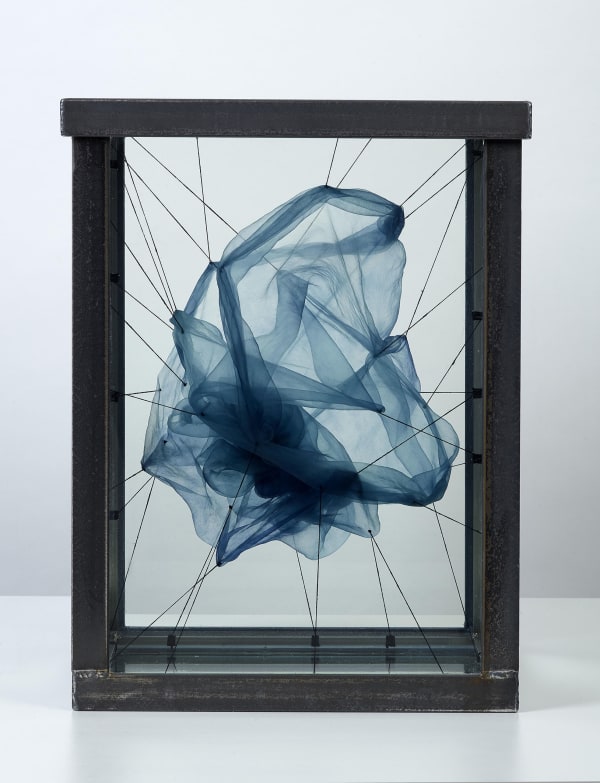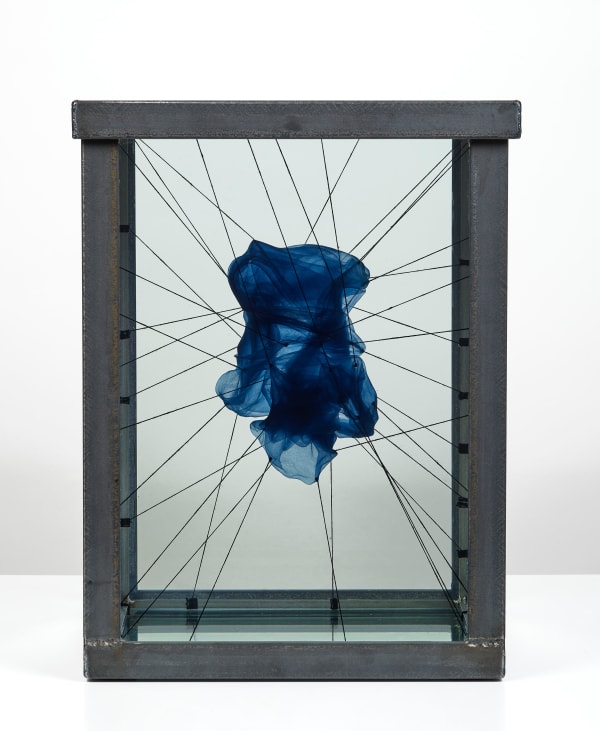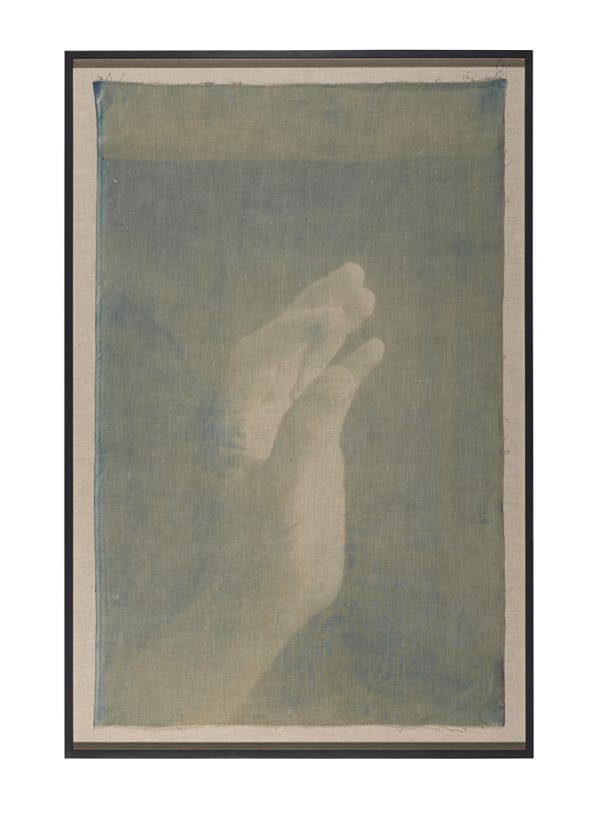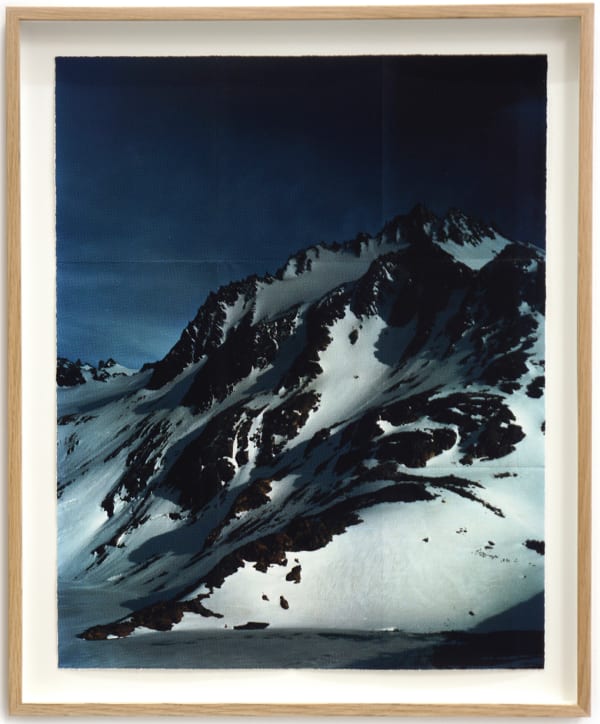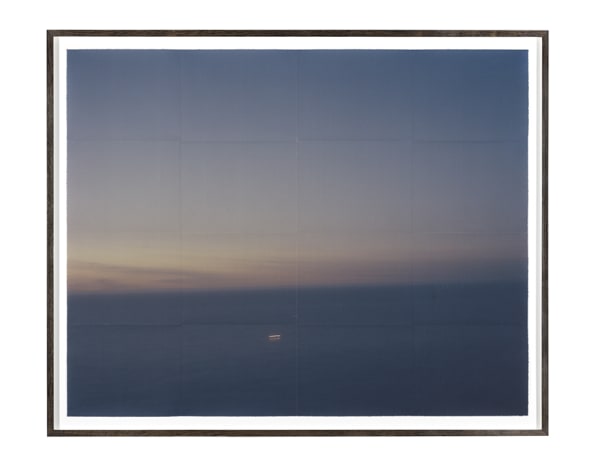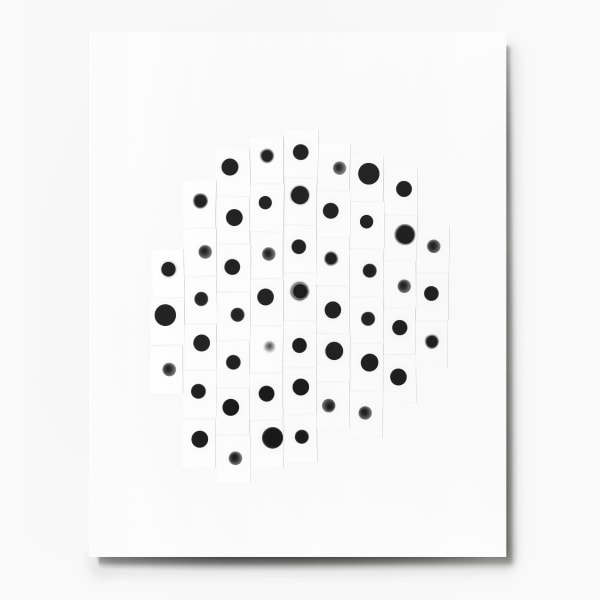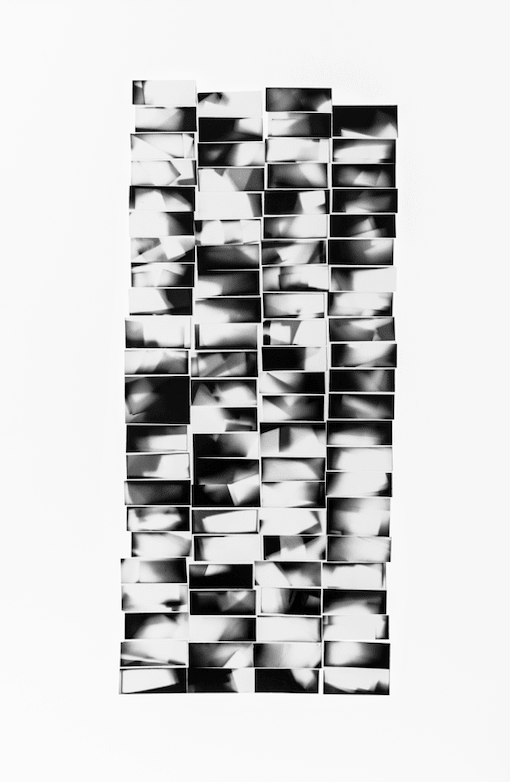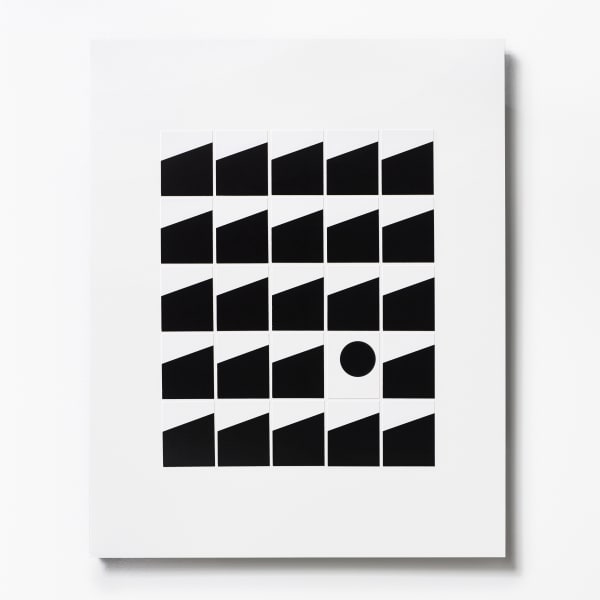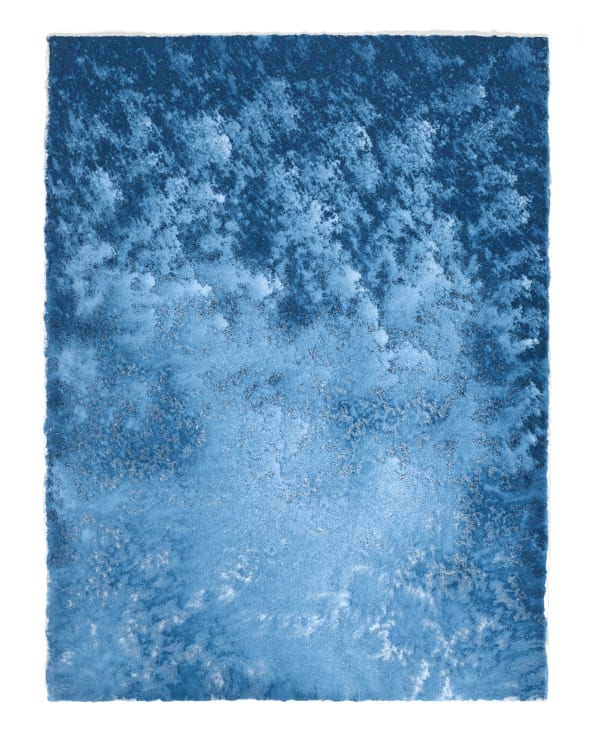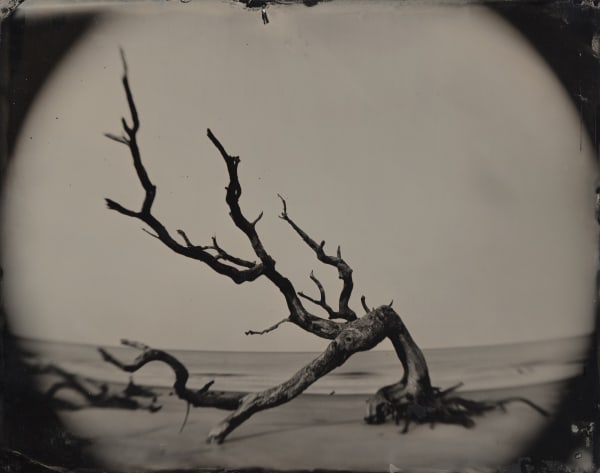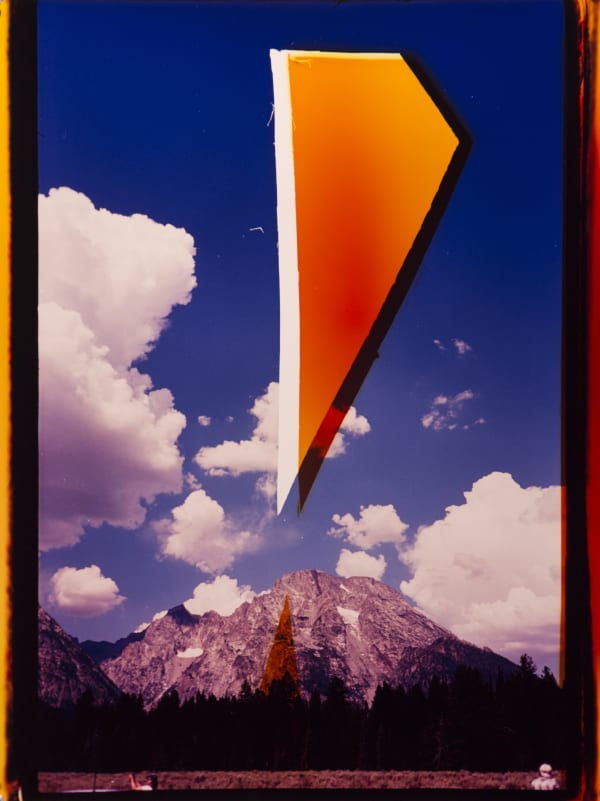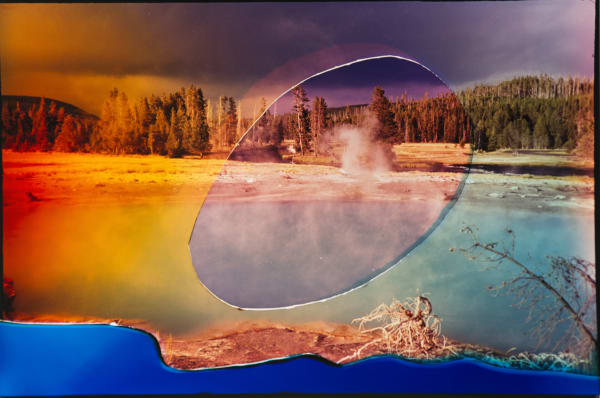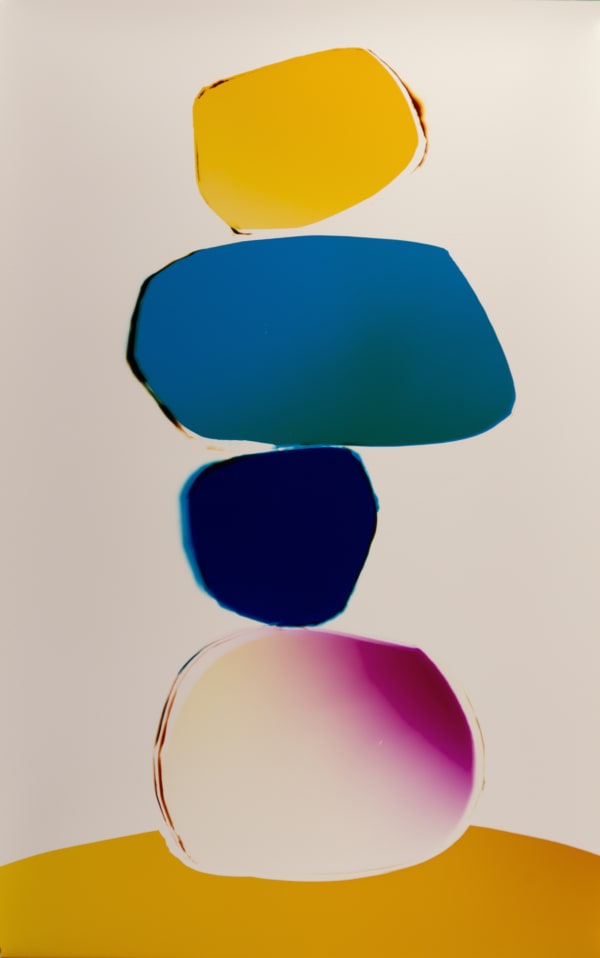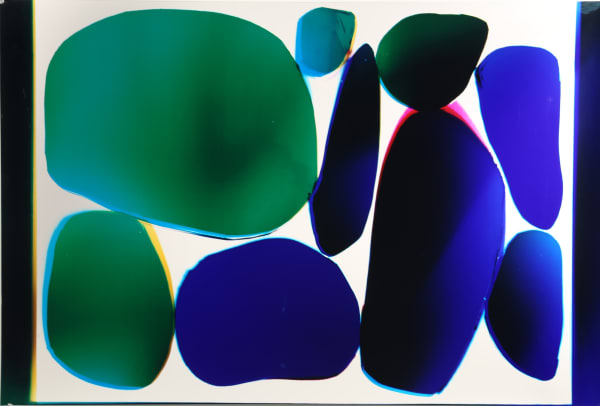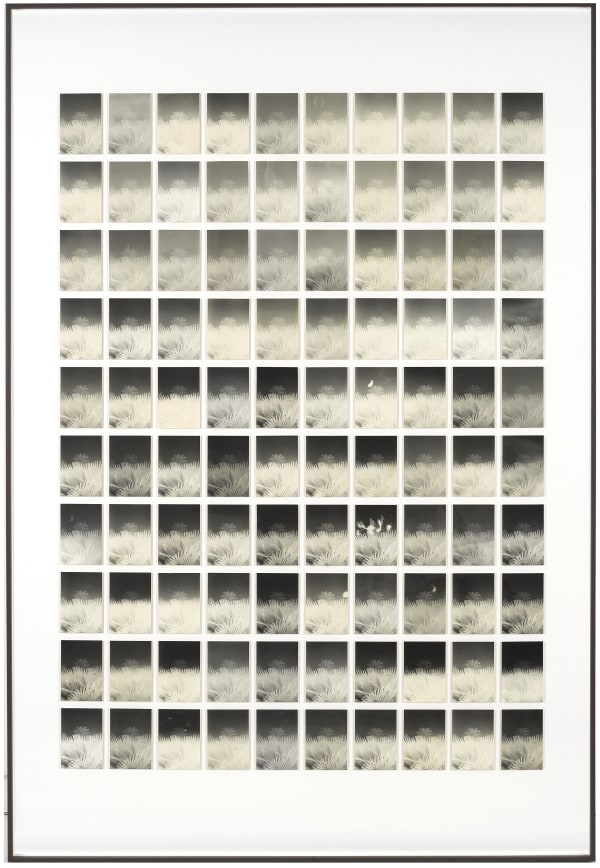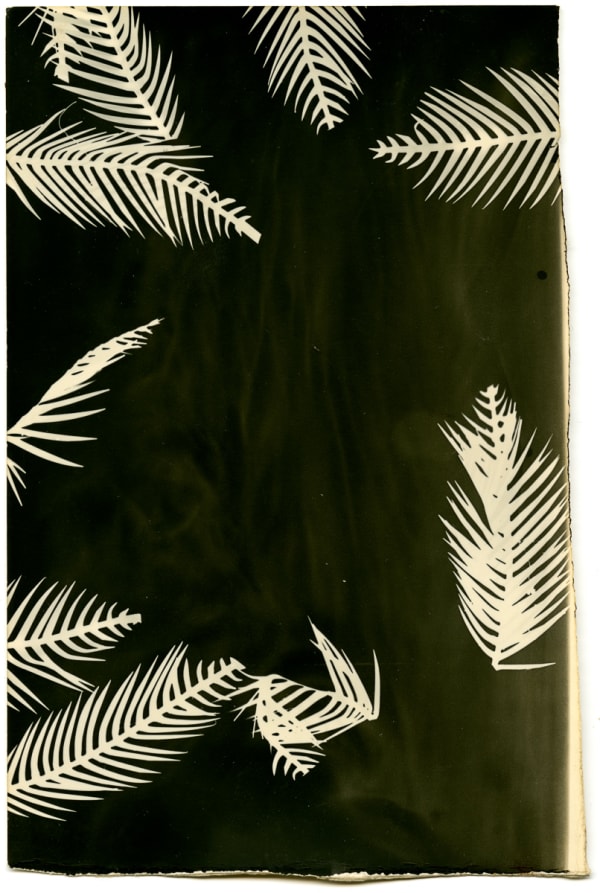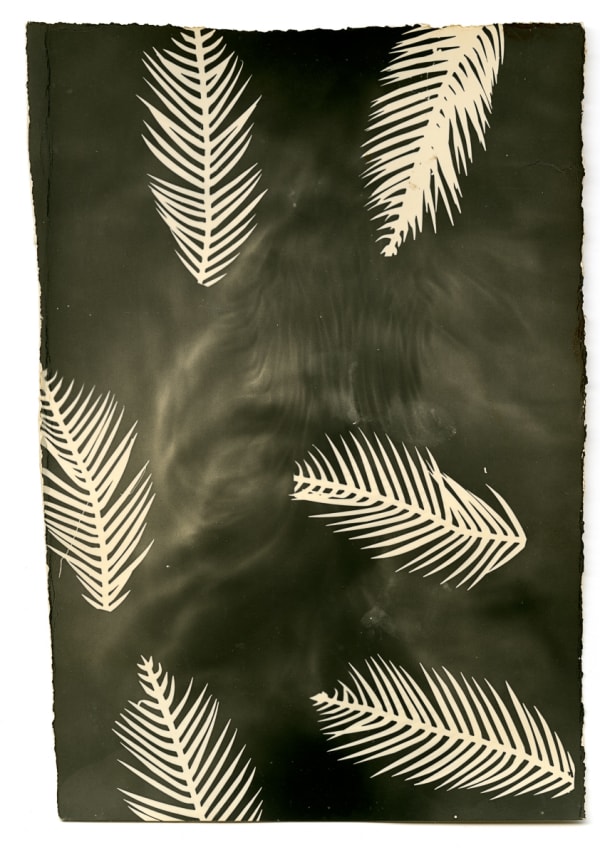Bringing together the work of eight international contemporary artists who apply historic photographic techniques to create innovative and unique artworks, Fundamentals would have been presented by Black Box Projects at Photo London 2020. The artists, many of whom work with handmade cameras, modified cameras, or no camera at all, are unified by their dedication to exploring the processes of the past and discovering novel approaches to factoring them into their practice, while redefining the very root of what photography can be.
This group of artworks includes such increasingly rare techniques as photograms, ambrotypes, cyanotypes, tin-types, wet-plate collodion prints and silver gelatin prints. In presenting these methods, Fundamentals provides an opportunity to examine why these rudimentary techniques have benefitted from a resurgence in popularity in today’s age of digital technology and social media.
Artist list: Adam Jeppesen, Joanne Dugan, Timo Lieber, Liz Nielsen, Chris McCaw, Steve Macleod, Bruno Roels and Joni Sternbach.
Accompanying the exhibition is a 48-page newsprint publication with an introduction by Martin Barnes, Senior Curator of Photographs, V&A.
*Please note prices are quoted including frame and inclusive of VAT, unless otherwise noted as print only.
**Prices and availability subject to change without prior notice.
-
 Adam JeppesenWork no. 146 (T), 2019Mixed media sculpture
Adam JeppesenWork no. 146 (T), 2019Mixed media sculpture
(Cyanotype on silk, natural fibre string, mineral oil, stainless steel and security glass)38.4 x 29.2 x 29.2 cm
15 1/8 x 11 1/2 x 11 1/2 inUniqueCourtesy of Black Box ProjectsCopyright Adam Jeppesen -
 Adam JeppesenWork no. 150 (T), 2019Mixed media sculpture
Adam JeppesenWork no. 150 (T), 2019Mixed media sculpture
(Cyanotype on silk, natural fibre string, mineral oil, stainless steel and security glass)40.5 x 30.2 x 25 cm
16 x 11 7/8 x 9 7/8 inUniqueCourtesy of Black Box ProjectsCopyright Adam Jeppesen -
 Adam JeppesenWork no. 147 (T), 2019Mixed media sculpture
Adam JeppesenWork no. 147 (T), 2019Mixed media sculpture
(Cyanotype on silk, natural fibre string, mineral oil, stainless steel and security glass)
Unique38.5 x 28 x 28 cm
15 1/8 x 11 1/8 x 11 1/8 inUniqueCourtesy of Black Box ProjectsCopyright Adam Jeppesen -
 Adam JeppesenWork no. 149 (T), 2019Mixed media sculpture
Adam JeppesenWork no. 149 (T), 2019Mixed media sculpture
(Cyanotype on silk, natural fibre string, mineral oil, stainless steel and security glass)38.5 x 28 x 28 cm
15 1/8 x 11 1/8 x 11 1/8 inUniqueCourtesy of Black Box ProjectsCopyright Adam Jeppesen -
 Adam JeppesenWork no. 133 (T), 2019Mixed media sculpture
Adam JeppesenWork no. 133 (T), 2019Mixed media sculpture
(Cyanotype on silk, natural fibre string, mineral oil, stainless steel and security glass)51.5 x 41.5 x 61 cm
20 1/4 x 16 3/8 x 24 1/8 inUniqueCourtesy of Black Box ProjectsCopyright Adam Jeppesen -
 Adam JeppesenWork no. 12, 2017Cyanotype on linen30.5 x 30.8 cm
Adam JeppesenWork no. 12, 2017Cyanotype on linen30.5 x 30.8 cm
12 1/8 x 12 1/8 inUniqueCourtesy of Black Box ProjectsCopyright Adam Jeppesen -
 Adam JeppesenWork no. 16, 2017Cyanotype on linen37.5 x 29 cm
Adam JeppesenWork no. 16, 2017Cyanotype on linen37.5 x 29 cm
14 3/4 x 11 3/8 inUniqueCourtesy of Black Box ProjectsCopyright Adam Jeppesen -
 Adam JeppesenWork no. 28, 2017Cyanotype on linen
Adam JeppesenWork no. 28, 2017Cyanotype on linen
Framed
Unique30.8 x 27.8 cm
12 1/8 x 11 inUniqueCourtesy of Black Box ProjectsCopyright Adam Jeppesen -
 Adam JeppesenWork no. 128, 2018Cyanotype on linen
Adam JeppesenWork no. 128, 2018Cyanotype on linen
Unique126.5 x 82.5 cm
49 3/4 x 32 1/2 inUniqueCourtesy of Black Box ProjectsCopyright Adam Jeppesen -
 Adam JeppesenWork no. 129, 2018Cyanotype on linen130 x 82 cm
Adam JeppesenWork no. 129, 2018Cyanotype on linen130 x 82 cm
51 1/8 x 32 1/4 inUniqueCourtesy of Black Box ProjectsCopyright Adam Jeppesen -
 Adam JeppesenWork no. 131, 2018Cyanotype on linen
Adam JeppesenWork no. 131, 2018Cyanotype on linen
Unique122.4 x 84.5 cm
48 1/4 x 33 1/4 inUniqueCourtesy of Black Box ProjectsCopyright Adam Jeppesen -
 Adam JeppesenAR Cerro A. Madsen, 2015Archival inkjet print on folded rice paper57.5 x 47 cm
Adam JeppesenAR Cerro A. Madsen, 2015Archival inkjet print on folded rice paper57.5 x 47 cm
22 5/8 x 18 1/2 inEdition 6/20 plus 2 artist's proofsCourtesy of Black Box ProjectsCopyright Adam Jeppesen -
 Adam JeppesenCL Copaipo, 2015Archival inkjet print on folded rice paper87 x 109 cm
Adam JeppesenCL Copaipo, 2015Archival inkjet print on folded rice paper87 x 109 cm
34 1/4 x 42 7/8 inEdition of 5 plus 2 artist's proofsCourtesy of Black Box ProjectsCopyright Adam Jeppesen -
 Adam JeppesenUS Pacific Ocean, 2015Archival inkjet print on folded rice paper88 x 109 cm
Adam JeppesenUS Pacific Ocean, 2015Archival inkjet print on folded rice paper88 x 109 cm
34 5/8 x 42 7/8 inEdition of 5 plus 2 artist's proofsCourtesy of Black Box ProjectsCopyright Adam Jeppesen -
 Joanne DuganEnlarger Lens Meditation #1, 2019Collage of 50 6.3 x 5 cm silver gelatin photograms
Joanne DuganEnlarger Lens Meditation #1, 2019Collage of 50 6.3 x 5 cm silver gelatin photograms
mounted to archival board and framed in a handmade white box frame with UV Perspex glazing
Unique101.6 x 81.3 cm
40 x 32 1/8 inCourtesy of Black Box ProjectsCopyright Joanne Dugan -
 Joanne DuganPaper Meditation #1 , 2019Collage of 90 silver gelatin photograms mounted to archival board and framed in a handmade white box frame with UV Perspex glazing
Joanne DuganPaper Meditation #1 , 2019Collage of 90 silver gelatin photograms mounted to archival board and framed in a handmade white box frame with UV Perspex glazing
Unique75.5 x 49.5 cm
29 3/4 x 19 1/2 inCourtesy of Black Box ProjectsCopyright Joanne Dugan -
 Joanne DuganMultiples 25, Grid #19, New York City, 2018Collage of 25 silver gelatin photograms mounted to archival board and framed in a handmade white box frame with UV Perspex glazing50.8 x 40.6 cm
Joanne DuganMultiples 25, Grid #19, New York City, 2018Collage of 25 silver gelatin photograms mounted to archival board and framed in a handmade white box frame with UV Perspex glazing50.8 x 40.6 cm
20 x 16 inEdition of three unique variants (#2)Courtesy of Black Box ProjectsCopyright Joanne Dugan -
 Joanne DuganMultiples 25, Grid #21, New York City, 2018Collage of 25 silver gelatin photograms mounted to archival board and framed in a handmade white box frame with UV Perspex glazing50.8 x 40.6 cm
Joanne DuganMultiples 25, Grid #21, New York City, 2018Collage of 25 silver gelatin photograms mounted to archival board and framed in a handmade white box frame with UV Perspex glazing50.8 x 40.6 cm
20 x 16 inEdition of three unique variants (#2)Courtesy of Black Box ProjectsCopyright Joanne Dugan -
 Joanne DuganCorner of Pearl and John Streets, facing Northwest, 10:16pm, New York City, 2013Silver gelatin print mounted to archival board and framed in a handmade white box frame with UV Perspex glazing50.8 x 40.6 cm
Joanne DuganCorner of Pearl and John Streets, facing Northwest, 10:16pm, New York City, 2013Silver gelatin print mounted to archival board and framed in a handmade white box frame with UV Perspex glazing50.8 x 40.6 cm
20 x 16 inEdition 3/20Courtesy of Black Box ProjectsCopyright Joanne Dugan -
 Timo LieberC-Blue #4, 2018Cyanotype
Timo LieberC-Blue #4, 2018Cyanotype
Framed
Unique117.5 x 167.5 cm
46 1/4 x 66 inCourtesy of Black Box ProjectsCopyright Timo Lieber -
 Timo LieberC-Blue #12, 2018Cyanotype
Timo LieberC-Blue #12, 2018Cyanotype
Framed
Unique76.5 x 57.5 cm
30 1/8 x 22 5/8 inCourtesy of Black Box ProjectsCopyright Timo Lieber -
 Joni Sternbach17.02.08 #7 In A Barrel, 2017Tintype
Joni Sternbach17.02.08 #7 In A Barrel, 2017Tintype
Framed in a handmade dark-stained walnut frame with museum glass
Unique27.9 x 35.6 cm
11 x 14 inCourtesy of Black Box ProjectsCopyright Joni Sternbach -
 Joni Sternbach15.02.18 #6 Afternoon at Orella Ranch, 2015Tintype
Joni Sternbach15.02.18 #6 Afternoon at Orella Ranch, 2015Tintype
Framed in a handmade dark-stained walnut frame with museum glass
Unique27.9 x 35.6 cm
11 x 14 in
Courtesy of Black Box ProjectsCopyright Joni Sternbach -
 Joni Sternbach11.03.17 #1 Kazzie, 2011Tintype
Joni Sternbach11.03.17 #1 Kazzie, 2011Tintype
Floated in a handmade dark stained box frame with museum glazing
Unique20.3 x 25.4 cm
8 x 10 inCourtesy of Black Box ProjectsCopyright Joni Sternbach -
 Joni Sternbach18.09.18 #1, Orange Lightning Bolt, 2018Tintype
Joni Sternbach18.09.18 #1, Orange Lightning Bolt, 2018Tintype
Framed in a handmade dark-stained walnut frame with museum glass
Unique25.4 x 20.3 cm
10 x 8 inCourtesy of Black Box ProjectsCopyright Joni Sternbach -
 Joni Sternbach04.05.20 #8 Beach Barrier, 2004Ambrotype
Joni Sternbach04.05.20 #8 Beach Barrier, 2004Ambrotype
Unique10.2 x 12.7 cm
4 x 5 inCourtesy of Black Box ProjectsCopyright Joni Sternbach -
 Joni Sternbach05.02.21 #8 Bent Tree / Jekyll Island, 2005Full Plate Ambrotype
Joni Sternbach05.02.21 #8 Bent Tree / Jekyll Island, 2005Full Plate Ambrotype
Unique20.3 x 25.4 cm
8 x 10 inCourtesy of Black Box ProjectsCopyright Joni Sternbach -
 Chris McCawHeliograph #2, 2012Silver gelatin paper negative
Chris McCawHeliograph #2, 2012Silver gelatin paper negative
Unique25.4 x 20.3 cm
10 x 8 inCourtesy of Black Box ProjectsCopyright The Artist -
 Chris McCawSunburned GSP#1031 (Mojave/expanding), 2019Silver gelatin paper negative
Chris McCawSunburned GSP#1031 (Mojave/expanding), 2019Silver gelatin paper negative
Unique20.3 x 25.4 cm
8 x 10 inCourtesy of Black Box ProjectsCopyright The Artist -
 Chris McCawSunburned GSP#1016 (Mexico), 2018Silver gelatin paper negatives
Chris McCawSunburned GSP#1016 (Mexico), 2018Silver gelatin paper negatives
Unique20.3 x 25.4 cm each
10 x 8 in eachCourtesy of Black Box ProjectsCopyright The Artist -
 Chris McCawHeliograph #129, 2016Silver gelatin paper negative
Chris McCawHeliograph #129, 2016Silver gelatin paper negative
Unique25.4 x 20.3 cm
10 x 8 inCourtesy of Black Box ProjectsCopyright The Artist -
 Chris McCawSunburned GSP#1023 (Mojave), 2019Silver gelatin paper negative
Chris McCawSunburned GSP#1023 (Mojave), 2019Silver gelatin paper negative
Unique27.9 x 35.6 cm
11 x 14 inCourtesy of Black Box ProjectsCopyright The Artist -
 Liz NielsenThe Meeting, 2019Analogue Chromogenic Photogram on Fujiflex
Liz NielsenThe Meeting, 2019Analogue Chromogenic Photogram on Fujiflex
Unique75 x 52.5 cm
20 5/8 x 29 1/2 in
Mounted to aluminium and framed in a handmade white box frame with UV Perspex glazeCourtesy of Black Box ProjectsCopyright Liz Nielsen -
 Liz NielsenWindow in Time, 2019Analogue Chromogenic Photogram on Fujiflex
Liz NielsenWindow in Time, 2019Analogue Chromogenic Photogram on Fujiflex
Unique50.2 x 75.2 cm
19 3/4 x 29 5/8 in
Mounted to aluminium and framed in a handmade white box frame with UV Perspex glazeCourtesy of Black Box ProjectsCopyright Liz Nielsen -
 Liz NielsenMountain Jewels, 2018Analogue Chromogenic Photogram on Fujiflex, Unique249 x 122.4 cm
Liz NielsenMountain Jewels, 2018Analogue Chromogenic Photogram on Fujiflex, Unique249 x 122.4 cm
98 1/8 x 48 1/4 in
Mounted to aluminium and framed in a handmade white box frame with UV Perspex glazeCourtesy of Black Box ProjectsCopyright Liz Nielsen -
 Liz NielsenUnderwater Mountains, 2018Analogue Chromogenic Photogram on Fujiflex, Unique126.8 x 200 cm
Liz NielsenUnderwater Mountains, 2018Analogue Chromogenic Photogram on Fujiflex, Unique126.8 x 200 cm
49 7/8 x 78 3/4 in
Mounted to aluminium and framed in a handmade white box frame with UV Perspex glazeCourtesy of Black Box ProjectsCopyright Liz Nielsen -
 Liz NielsenStormy Mountain Shapes, 2019Analogue Chromogenic Photogram on Fujiflex
Liz NielsenStormy Mountain Shapes, 2019Analogue Chromogenic Photogram on Fujiflex
Print only
Unique20.3 x 25.4 cm
8 x 10 inCourtesy of Black Box ProjectsCopyright Liz Nielsen -
 Liz NielsenDancing with you, 2019Analogue Chromogenic Photogram on Fujiflex
Liz NielsenDancing with you, 2019Analogue Chromogenic Photogram on Fujiflex
Print only
Unique25.4 x 20.3 cm
10 x 8 inCourtesy of Black Box ProjectsCopyright Liz Nielsen -
 Liz NielsenSummer Stone Stack, 2019Analogue Chromogenic Photogram on Fujiflex
Liz NielsenSummer Stone Stack, 2019Analogue Chromogenic Photogram on Fujiflex
Mounted to aluminium and floated in a handmade white box frame with museum glass76.2 x 53.3 cm
30 x 21 inCourtesy of Black Box ProjectsCopyright Liz Nielsen -
 Liz NielsenSpring Stone Stack, 2019Analogue Chromogenic Photogram on Fujiflex
Liz NielsenSpring Stone Stack, 2019Analogue Chromogenic Photogram on Fujiflex
Mounted to aluminium and floated in a handmade white box frame with museum glass76.2 x 53.3 cm
30 x 21 inCourtesy of Black Box ProjectsCopyright Liz Nielsen -
 Liz NielsenCool Stones, 2018Analogue Chromogenic Photogram on Fujiflex, Unique75.9 x 112.4 cm
Liz NielsenCool Stones, 2018Analogue Chromogenic Photogram on Fujiflex, Unique75.9 x 112.4 cm
29 7/8 x 44 1/4 in
Mounted to aluminium and framed in a handmade white box frame with UV Perspex glazeCourtesy of Black Box ProjectsCopyright Liz Nielsen -
 Liz NielsenWarm Stones, 2018Analogue Chromogenic Photogram on Fujiflex, Unique75.9 x 113 cm
Liz NielsenWarm Stones, 2018Analogue Chromogenic Photogram on Fujiflex, Unique75.9 x 113 cm
29 7/8 x 44 1/2 in
Mounted to aluminium and framed in a handmade white box frame with UV Perspex glazeCourtesy of Black Box ProjectsCopyright Liz Nielsen -
 Steve MacleodIndigo 1, 2019Selenium-toned silver gelatin print in bespoke dark-blue artist's frame with museum glazing20 x 25 cm
Steve MacleodIndigo 1, 2019Selenium-toned silver gelatin print in bespoke dark-blue artist's frame with museum glazing20 x 25 cm
7 7/8 x 9 7/8 inEdition 1/3Courtesy of Black Box ProjectsCopyright Steve Macleod -
 Steve MacleodIndigo 3, 2019Selenium-toned silver gelatin print20 x 25 cm
Steve MacleodIndigo 3, 2019Selenium-toned silver gelatin print20 x 25 cm
7 7/8 x 9 7/8 in
Bespoke artist's frame, sprayed dark blue with museum glazingEdition 1/3Courtesy of Black Box ProjectsCopyright Steve Macleod -
 Steve MacleodIndigo 18, 2019Selenium-toned silver gelatin print in bespoke dark-blue artist's frame with museum glazing20 x 25 cm
Steve MacleodIndigo 18, 2019Selenium-toned silver gelatin print in bespoke dark-blue artist's frame with museum glazing20 x 25 cm
7 7/8 x 9 7/8 inEdition 1/3Courtesy of Black Box ProjectsCopyright Steve Macleod -
 Steve MacleodOn Boundary Stones, 1992-2005Silver gelatin print, with Winsor & Newton black oil stick applied by hand. Unique.16 x 12 inches / 40.6 x 50.8 cm paper size
Steve MacleodOn Boundary Stones, 1992-2005Silver gelatin print, with Winsor & Newton black oil stick applied by hand. Unique.16 x 12 inches / 40.6 x 50.8 cm paper size
Framed in a handmade charcoal black frame with matching mountCourtesy of Black Box ProjectsCopyright Steve Macleod -
 Steve MacleodOff Far Rock, 1992-2005Silver gelatin print, with Winsor & Newton black oil stick applied by hand. Unique.16 x 12 inches / 40.6 x 50.8 cm paper size
Steve MacleodOff Far Rock, 1992-2005Silver gelatin print, with Winsor & Newton black oil stick applied by hand. Unique.16 x 12 inches / 40.6 x 50.8 cm paper size
Framed in a handmade charcoal black frame with matching mountCourtesy of Black Box ProjectsCopyright Steve Macleod -
 Steve MacleodThe Creel Cuts, 1992-2005Silver gelatin print, with Winsor & Newton black oil stick applied by hand. Unique.16 x 12 inches / 40.6 x 50.8 cm paper size
Steve MacleodThe Creel Cuts, 1992-2005Silver gelatin print, with Winsor & Newton black oil stick applied by hand. Unique.16 x 12 inches / 40.6 x 50.8 cm paper size
Framed in a handmade charcoal black frame with matching mountCourtesy of Black Box ProjectsCopyright Steve Macleod -
 Bruno V. RoelsA Palm Tree Is A Palm Tree Is A Palm Tree (Hiding In The Back), 2016Composition of 100 fibre-based silver gelatin prints
Bruno V. RoelsA Palm Tree Is A Palm Tree Is A Palm Tree (Hiding In The Back), 2016Composition of 100 fibre-based silver gelatin prints
Unique117 x 80 cm
46 1/8 x 31 1/2 inCourtesy Black Box Projects in collaboration with Gallery Fifty OneCopyright Bruno V. Roels -
 Bruno V. RoelsA Palm Tree Is A Palm Tree Is A Palm Tree (Night Giant), 2015Composition of 100 fibre-based silver gelatin prints
Bruno V. RoelsA Palm Tree Is A Palm Tree Is A Palm Tree (Night Giant), 2015Composition of 100 fibre-based silver gelatin prints
Unique135 x 92 cm
53 1/8 x 36 1/4 inCourtesy Black Box Projects in collaboration with Gallery Fifty OneCopyright Bruno V. Roels -
 Bruno V. RoelsPalmograph #3, 2019Silver gelatin print
Bruno V. RoelsPalmograph #3, 2019Silver gelatin print
Unique40 x 30 cm
15 3/4 x 11 3/4 inCourtesy Black Box Projects in collaboration with Gallery Fifty OneCopyright Bruno V. Roels -
 Bruno V. RoelsPalmograph #4, 2019Silver gelatin print
Bruno V. RoelsPalmograph #4, 2019Silver gelatin print
Unique40 x 30 cm
15 3/4 x 11 3/4 inCourtesy Black Box Projects in collaboration with Gallery Fifty OneCopyright Bruno V. Roels -
 Bruno V. RoelsThe Pyramids and Palm Trees Test (Perfection Part I), 2018Composition of four silver gelatin prints
Bruno V. RoelsThe Pyramids and Palm Trees Test (Perfection Part I), 2018Composition of four silver gelatin prints
Unique60 x 50 cm
23 5/8 x 19 3/4 inCourtesy Black Box Projects in collaboration with Gallery Fifty OneCopyright Bruno V. Roels -
 Bruno V. RoelsPalmerar d’Elx, 2018Watercolour on overprinted silver gelatin paper
Bruno V. RoelsPalmerar d’Elx, 2018Watercolour on overprinted silver gelatin paper
Unique50 x 40 cm
19 3/4 x 15 3/4 inCourtesy Black Box Projects in collaboration with Gallery Fifty OneCopyright Bruno V. Roels -
 Bruno V. RoelsBreaking Promises, 2018Graphite on overprinted silver gelatin paper
Bruno V. RoelsBreaking Promises, 2018Graphite on overprinted silver gelatin paper
Unique50 x 40 cm
19 3/4 x 15 3/4 inCourtesy Black Box Projects in collaboration with Gallery Fifty OneCopyright Bruno V. Roels
Artist Information
Chris McCaw (USA, lives in California) uses hand-built cameras with vintage photographic paper as negatives. His artistic process is firmly rooted in the history of photography while simultaneously pushing the medium in new directions and recalls the work of photography pioneer, Henry Fox Talbot, combined with the slash and burn paintings of Lucio Fontana. He photographs the sun, making minutes, hours, or even many day-long exposures, that burn the sun’s path onto the paper and capture its movements against its land or sea background. Long exposures throughout a day, or over multiple days, materialise as marks and burns made directly by the sun’s light as the paper is exposed. The subject of the photograph (the sun) disrupts the idea that a photograph is simply a representation of reality. Instead it becomes a physical embodiment of the Earth’s movement and the passage of time.
Joanne Dugan (USA, lives in New York) produces collages made up of silver gelatin prints created without the use of a camera. She painstakingly hand cuts and hand paints her compositions using historic printing techniques and vintage equipment to pay homage to the physical limitations and opportunities found in analogue methods. Dugan views this process as a meditative one, ‘The darkroom is, for me, a refuge from the infiltration of technology and the fastness it represents. One goal with these works is to retain visual evidence of the hand used in making them.
Timo Lieber (Germany, lives in London) has, for the first time in his career, turned to the historic technique of cyanotype. C-Blue was born out of Lieber’s fascination with the Arctic and his shock at the desperately fast and potentially irreversible changes that have been caused to the environment. From lithium mines in the Atacama Desert to the world’s largest lignite open pit mine in Germany, Lieber has photographed various landscapes forever altered by resource extraction. It is the delicate fragility of the ice cap, however, that he keeps revisiting. To obtain images that chart the ice metamorphosis rather than merely document the result, Lieber returned to the 19th Century cameraless technique that utilises daylight to expose paper coated with a light-sensitive solution. Melting ice crystals reflects the light and leaves traces on the canvas. As in nature meticulous planning conflicts with the laws of physics resulting in images as unique as the combined impact of all the elements that have come together to create them.
Joni Sternbach (USA, lives in New York) uses both large-format film and early photographic processes to explore the present-day landscape to make environmental portraits. Her work centres on our relationship with water, contrasting some of the most desolate deserts in the American West with iconic surf beaches around the world that captures thirteen years of portraits of surfers in tintype. She works with a large-format camera and a wet-collodion process that must be prepared and developed in situ. The very nature of collodion is spontaneous and unpredictable. It is precisely this raw quality of the process that suits the subject matter, giving it a distinctive appearance and echoing important traditions of 19th-century anthropological photography.
Adam Jeppesen (Denmark, lives in Argentina) creates work that addresses the materiality and transience of the photograph as an object. Much of Jeppesen's work is the result of a solitary 487-day journey from the North Pole to Antarctica in 2007. The journey has left visible traces and blemishes on the photographs as he carried his film and camera equipment with him on the road, where the negatives picked up grit and dust along the way. Jeppesen celebrates these imperfect elements rather than tries to hide them. Coincidence, damage and imperfection are essential elements in his work. At a time when the image has become infinitely perfectible and reproducible, Jeppesen experiments with the photograph as a unique object that is subject to the forces of change and decay.
Liz Nielsen (USA, lives in New York) uses a contemporary application of one of the best-known avant-garde photographic processes - the photogram - which was first mastered by Man Ray and Maholy-Nagy at the beginning of the 20th Century. Each unique colour image is created without a camera by placing objects directly onto photographic paper and exposing them to light. 'The final outcomes are pre-planned with strong intention and formally composed,' she explains, 'but because I'm working with light, they always have some surprises. The light bleeds and spills and doesn't want to be contained.'
Steve Macleod (Scotland, lives in London) is inspired by the Pictorial movement popularised in the late 19th and early 20th centuries. For a Pictorialist, a photograph, like a painting, drawing or engraving, is a way of projecting an emotional intent into the viewer's realm of imagination. His works often utilise chiaroscuro elements of light and shade creating a melancholic, expressive mood. Macleod shoots on a large-format camera with a consistently systematic and meticulous approach so that he can absorb and slow the pace of the images. He creates a stillness, a sense of extended present time through narrow depth of field and camera movements, there is an obtuse visibility of detail - the aim is to question what lies between the elements beyond and within photographs, by decelerating the process of photography, with a distilled focus on the basic principles of making.
About Black Box Projects
Founded in 2017, Black Box Projects specialises in contemporary photography and contemporary art that is created using photographic materials. Committed to working with artists who push the limits of traditional photographic practice, Black Box Projects does not keep a permanent space, instead arranging project-based exhibitions in order to tailor the experience to the individual needs of the artist and the work exhibited. Black Box Projects aims to be a pioneer of the changing gallery model, as well as presenting a transparent working model with artists, clients and other gallerists that fosters community, creativity and collaboration.

